新生代英语基础教程1 Unit 3_电子教案
- 格式:doc
- 大小:131.00 KB
- 文档页数:28
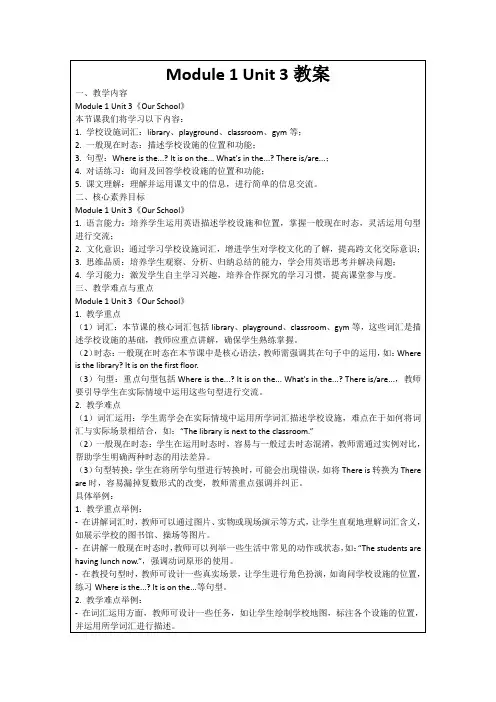
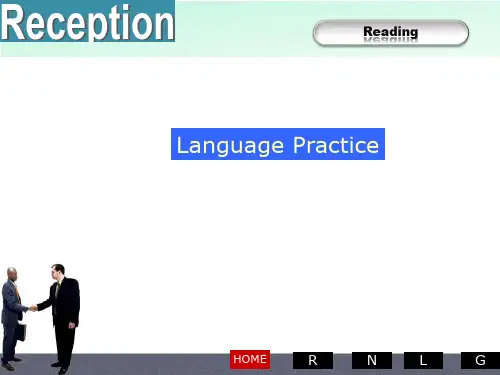


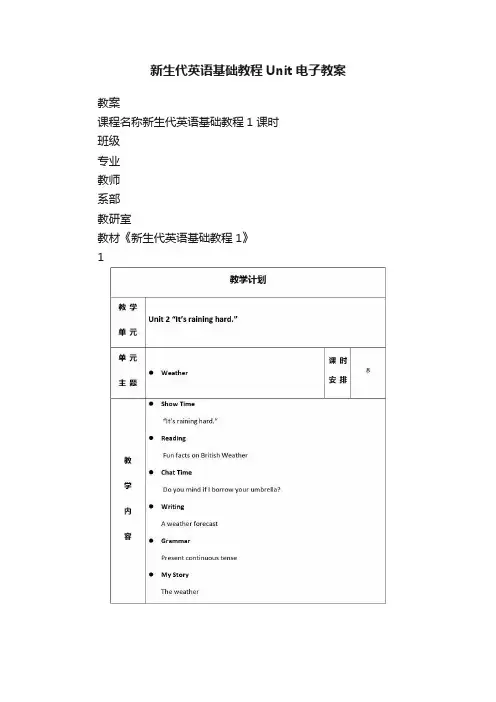
新生代英语基础教程Unit电子教案教案课程名称新生代英语基础教程1 课时班级专业教师系部教研室教材《新生代英语基础教程1》1345678补充教学资源VOCABULARY BUILDER参考译文SHOW TIME语言解析1. It’s ten after three.三点过十分了。
ten after three 三点过十分,这个短语相当于ten past three。
英语中表示“几点过几分”(半小时以内)可用after,也可用past;而表示“几点差几分”则用to,通常先讲分钟,再讲小时, 即after / past 或to前面的数字为分钟,后面的数字为小时。
e.g. 5:10 ten past five (ten after five)10:05 five past ten (five after ten)5:50 ten to six9:45 fifteen to ten2. The class is canceled because of the storm. 因为暴雨,课被取消了。
because of意思是“因为”,是一个介词短语,后面跟名词或动名词,构成介宾结构。
because是连词,后面跟句子。
9e.g. The plane didn’t take off because of the heavy rain.因为大雨,飞机没有起飞。
The plane didn’t take off because it was raining heavily.因为下大雨,飞机没有起飞。
3.Nobody came to class—except us.除了我们几个,没有人来上课了。
except 表示“除……之外”,强调所排除的“不包括在内”,一般表示同类之间的关系。
besides表示“除……以外还……”,有“不但……而且……”的意思。
e.g. The library is open every day except Mondays.除了星期一,图书馆每天都开放。
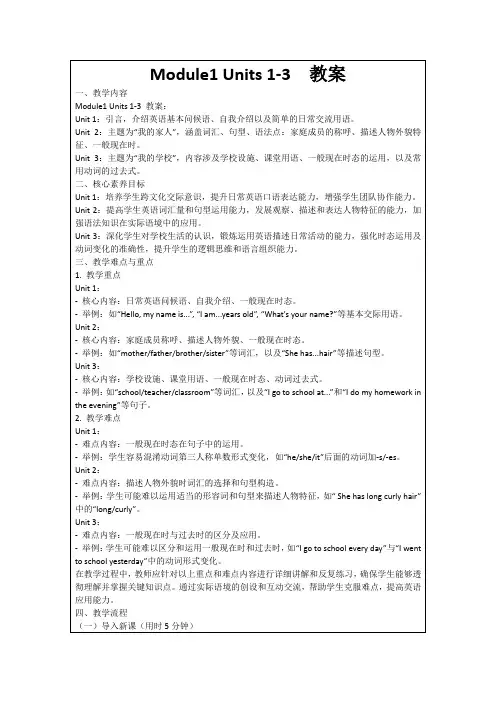
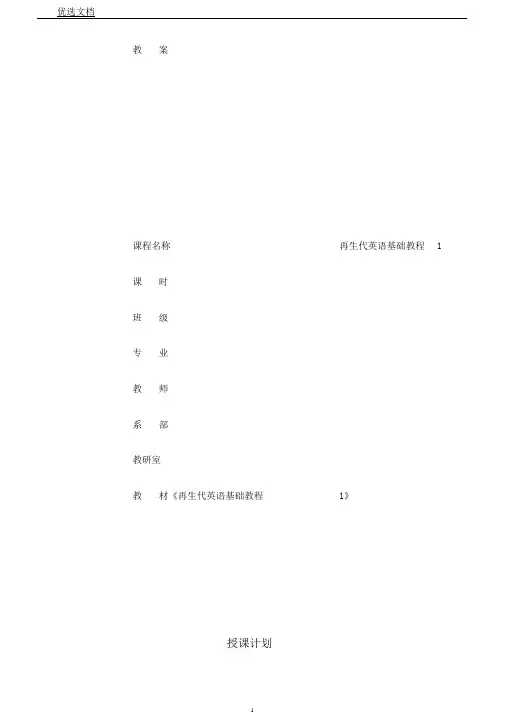
优选文档教案课程名称再生代英语基础教程 1课时班级专业教师系部教研室教材《再生代英语基础教程1》授课计划授课单元Unit2“It’sraininghard.”单元主题WeatherShowTime“It’sraininghard.”ReadingFunfactsonBritishWeather教ChatTime学DoyoumindifIborrowyourumbrella内Writing容AweatherforecastGrammarPresentcontinuoustense MyStoryTheweather授课目标课时8安排授课活动建议Warm-up Togetstudentstotalk aboutthemaintopicofthisunitin acomfortableandrelaxedmannerVocabularyBuilderAandBTo teach students Havestudents look atthepicture and askthemto tell youasmuchastheycanaboutit.Then,gothroughthequestions andcomplete eachanswer. Readtheparagraphtogetherandchecktheiranswers.Havethestudentslistenandrepeatthewords.Askthestudentswhichnew vocabulary relatedtoweather and weather clothingCandDTo improve students’listening and comprehension skills words theyknow and which they aren’t sure about.The most difficult wordsonthis list are probably ponchoandcanceled.If you havearealponcho,itmaybegood tobringittoclass.Forcanceled,youcan give an example of when school was canceled recently, perhapsduetoapublicholidayorpoor weather.Try to relate the vocabularytostudents’livesas muchaspossible. Talkaboutweatherconditionswith students.Askquestionslike“Doyou like a rainy day”Students should answerinacomplete sentence beginning with“I like/don’t likea⋯day.”Finishtheexerciseandchecktheiranswers. ForExercise C,tell the students that they will hear a weather forecast.Explain that aforecast is when people try to predict(or guess)what the weather will be. Reviewthe wordsdescribing weather withstudentslikesunny,rainyandstormy.Showsome examples to prime the students for the listening.Now, listen to the forecast.Have students fill in the correct answers,pausingtherecordingifnece ssary.ChecktheiranswersandShowTime ATo teachstudentslistening andspeaking skillsthroughtheuseofvideo listenagain. ReadthoughWordsandExpressions.Askthemquestions abouttheirfavoriteweatherandthenhavethem practicesuchconversationsinpair.For exercise D, the teacher candesign agame.Divide theclass into sixgroups,eachgroupchoosingonetask.Then students select nouns thatcangowiththeadjectivesinethesewordstomake sentencesormakeupasmallstory.First,havethestudentswatchthe picturesandreadstatements below.Ask basic comprehension questionssuch as,“Who are the main charactersinthisvideo”“Whereare they”“Whataretheydoing”“Whyaretheydoingthat”“How aretheydoingit”Tryto matcheach statementtothepicture.Next,have students take turns in explaining whatishappening in each picture.You can do the firstpicture,and then have a more confident student try the secondone.Tomakeitmorefun,youcould choosetwostudents,andthenhavethem race to explain what is happening in the picture.The studentwiththefastestandbestexplanationwins.B,CandDTo improvestudents’listeningcomprehensionthroughtheuseofvideoReading A,BandCTo improvestudents’readingcomprehension ForExerciseB,havestudentsreadeachstatement.Playth evideoandremindthemtopayattentiontohowNaomi,Mat eoandHectordescribetheweather.Thenhavestudentsfin ishtheexerciseandchecktheiranswers.Askstudentswhystat ementFiswrong.Before doing Exercise C,youmayask studentsto guessthe missing words. Thenplaythevideoagain.Youcan pausethevideowhenyoureachthe partofthedialoguewithmissing wordsandhavestudents call out the answers.Check their answers and havethemreadthedialogue.(Ask threestudentstorole-playorhaveboys read Hector’s lines while girlsNaomi’sandtheteacheractsasMateo.)Finally,for Exercise D,havestudents put the events is the correctordertocompleteExerciseD.Checktheiranswersandreadthesentences in correct order together.Iftimepermits,playthevideobutturnoffthevolume.Havest udentsdubthecharacters.First,havethestudentsreadtextquietlyandreadthroughsen tencesin Exercise A. After they have finishedtheexercise,checktheir answersandaskthemfor proofs fromthetext.DTo awake theirawareness ofculturaldifferenceChatTime A,BandCTo improvestudents’listening,speaking,writingand acting skillsthroughtheuseofconversation Askstudentstoreadthetextagaininthreeminutes.ThenhavethemfinishtheExerciseB.Mak ethemunderstandthattheydon’tneedfigureoutthemeani ngofeverywordtoanswerthequestions.ForExerciseC,havestudentsreadnewwordsinboxes.Corre cttheirpronunciation.Thenhavethemfinishtheexercise.Askstu dentstoreadthecompletesentencesandcorrecttheirmist akes.ForExerciseD,askstudentsto readEnglish expressions.If they encounter newwords,encourage them toguessthemeaning.Thenyoumayexplain what they fail to understand.Have them finish the exerciseandchecktheiranswers.Finally,you sayChineseproverbsandletstudentssaycor respondingEnglishones.ForExerciseA,explaintostudentsthattheywill hearaconversationbetweentwopeopledisc ussingtheweather.Encouragethemtoguessthemissing information.Tell the studentstolistencarefullyandwritedownwha ttheyhearintheblankspaces.Ifnecessary,pause therecordingsothatstudentshavetimetowrite.Next,havestudentspracticeaskingafavorinpairs,monitoringthemwhiletheydoso.ForExerciseB,havestudentspracticethedial ogueinexampleinWriting A,BandCTo improvestudents’writingskills andlearn towrite a weatherforecast.Grammar AandBTo teachstudentshowtousepresentcontinuoustense pair.Write m orephrases such as“closethedoor,openthewindow,borrowyourbikeontheb lackboard”formorepractices.ForExerciseC,havestudents perform adialogueaboutaskingforaliftin a rainy day.Monitor their performanceandprovidehelpwhennecessary.Havestudentsreadthepictureand teachthemhowtogetinformationfrom a weather forecast picture. Havethemlookthroughwordsinthe boxesandfillintheblanks.Theteacher gives necessary explanation,such as the pronunciationof16℃.Checktheiranswers and have them read sentences. HavestudentsfinishExerciseBandencou ragethemtodiscusswithpartners.ForExercise C,divide theclassintoseveralgroups.Groupmembersdiscussa ndpredicttheweatherconditiononweekends.LookbacktoExerciseAandBasclues.Inviterepresentativestoperformaweatherforecast.Explaintostudentsthatweusethe presentcontinuoustensetodescribeanac tionhappeningnoworintheverynearfuture.Givesomeexamplessuchas“Youaresittinginclassnow.”“IamteachingyouMyStory To improve students’listening comprehension and speaking ability throughtheuseof video now.”Inaddition,pointoutthatweuseitforactionsthathappen “closetonow,”forexample,todayortonight.Again,giveexam ples,askingyourstudents“Whatareyoudoingtoday/tonight”Remindstudents that thestructure weusefor this tenseis“Subject+be+v-ing.”Writethisstructureon theboardandhavestudents practiceout loud.You may also want to brieflyexplaintherulesofadding“ing.”Studentsessentiallyneedtoknowtherulesregarding“e”(cut e add ing),“ie”(cut ie addying),suchashaveandtake;andconsonant–short vowel–consonant(in which we doublethe lastconsonant),suchasputandrun.Oncestudents seemcomfortable usingthetense,havethemdoExerciseA,checkingformistakeswhentheyarefinished. Havestudentsmakeupashortstoryusingcontinuoustensewi ththepictureandwordsgiven.Askquestionsandanswerbasedont hepicture.Dothisinpairoringroup.Tellthestudentsthattheywillsee a video inwhichreal people talkabouttheweatherintheplacestheycomefrom.Aplacestudentsmaynotknowis“Jamaica.”Nowwatchthevideo andhavestudents complete thetrueorfalsestatements.Insomecases,youmayneed topause the作业课后总结与反省video t ohelp thestudents.Nowhavestudents tell you the answers, correctinganymistakes.Watchthevideoagainandhavestudents write inthemissing words,pausing the video i f necessary.Check the students’answers, correctinganymistakes.Thereare several waysto conductExercise C.students mayanswersthequestionsbythemselvesandmakeupashortpassageaccordingtotheiranswers.Or students make updialoguesinpair.Orhavestudentsmovefreely in the class and askclassmates the questions.Invitesomestudentsto doareport infrontoftheclass.课后学习设计FinishalltheexercisesinUnit2. Readthetextinthisunitagainand trytosummariseitscontent.Writeaweatherforecast according tothe local weather broadcastprogramme.补充授课资源VOCABULARYBUILDER参照译文您正在收听的是您最喜欢的广播电台,“波浪”调频广播。

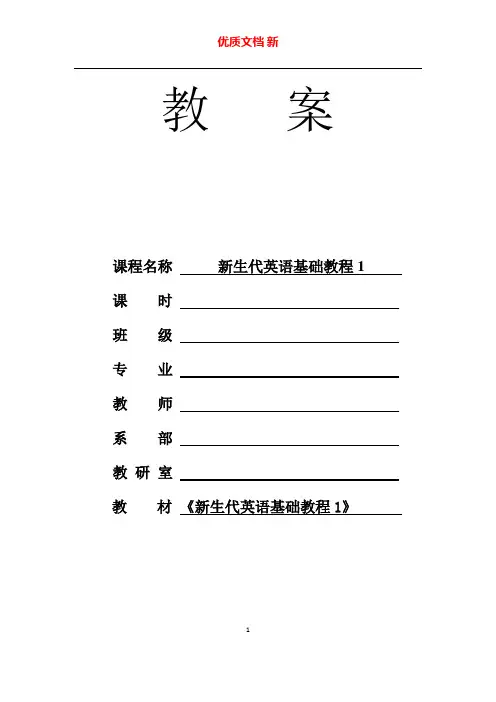
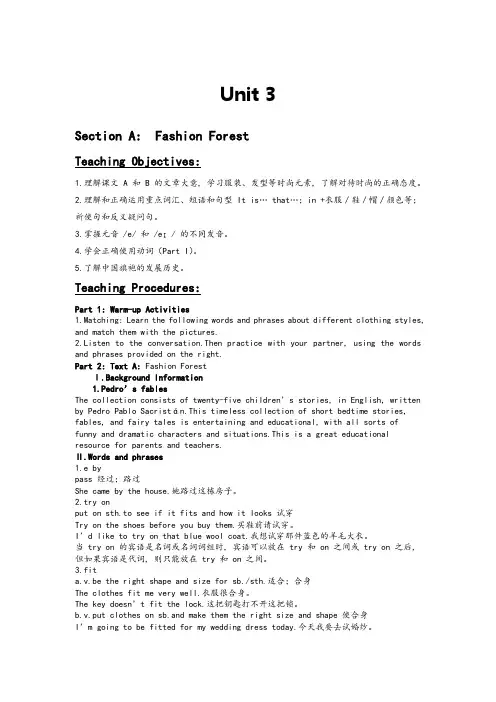
Unit 3Section A: Fashion ForestTeaching Objectives:1.理解课文 A 和 B 的文章大意, 学习服装、发型等时尚元素, 了解对待时尚的正确态度。
2.理解和正确运用重点词汇、短语和句型 It is… that…;in +衣服/鞋/帽/颜色等;祈使句和反义疑问句。
3.掌握元音 /e/ 和 /eɪ/ 的不同发音。
4.学会正确使用动词(Part I)。
5.了解中国旗袍的发展历史。
Teaching Procedures:Part 1: Warm-up Activities1.Matching: Learn the following words and phrases about different clothing styles, and match them with the pictures.2.Listen to the conversation.Then practice with your partner, using the words and phrases provided on the right.Part 2: Text A: Fashion ForestⅠ.Background Information1.Pedro’s fablesThe collection consists of twenty-five children’s stories, in English, written by Pedro Pablo Sacristán.This timeless collection of short bedtime stories, fables, and fairy tales is entertaining and educational, with all sorts offunny and dramatic characters and situations.This is a great educational resource for parents and teachers.Ⅱ.Words and phrases1.e bypass 经过;路过She came by the house.她路过这栋房子。
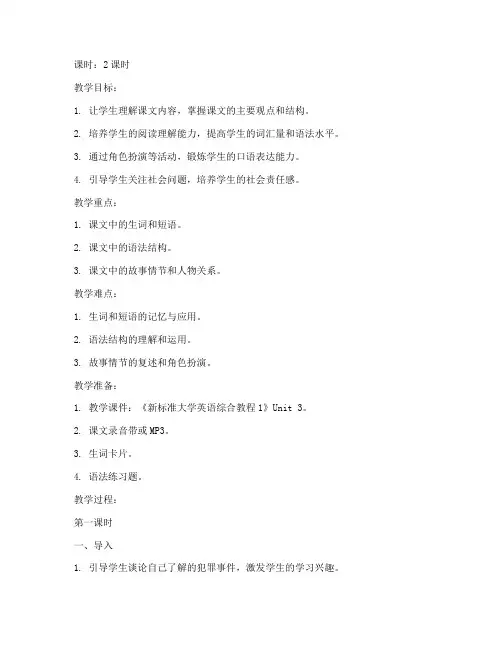
课时:2课时教学目标:1. 让学生理解课文内容,掌握课文的主要观点和结构。
2. 培养学生的阅读理解能力,提高学生的词汇量和语法水平。
3. 通过角色扮演等活动,锻炼学生的口语表达能力。
4. 引导学生关注社会问题,培养学生的社会责任感。
教学重点:1. 课文中的生词和短语。
2. 课文中的语法结构。
3. 课文中的故事情节和人物关系。
教学难点:1. 生词和短语的记忆与应用。
2. 语法结构的理解和运用。
3. 故事情节的复述和角色扮演。
教学准备:1. 教学课件:《新标准大学英语综合教程1》Unit 3。
2. 课文录音带或MP3。
3. 生词卡片。
4. 语法练习题。
教学过程:第一课时一、导入1. 引导学生谈论自己了解的犯罪事件,激发学生的学习兴趣。
2. 介绍本课的主题:Crime Watch。
二、课文阅读1. 学生阅读课文,注意理解课文内容,掌握课文结构。
2. 教师提问,检查学生对课文的理解。
三、词汇学习1. 教师带领学生学习课文中的生词和短语,并进行讲解。
2. 学生跟读生词和短语,加深记忆。
四、语法讲解1. 教师讲解课文中的语法结构,如:现在完成时、条件状语从句等。
2. 学生练习语法,巩固所学知识。
五、课堂活动1. 学生分组讨论课文中的犯罪事件,分析原因和后果。
2. 学生进行角色扮演,模拟警察和罪犯的对话。
第二课时一、复习导入1. 复习上一节课的学习内容,检查学生对课文的理解和语法掌握情况。
2. 引导学生谈谈自己对犯罪问题的看法。
二、课文复述1. 学生分组复述课文内容,注意使用所学词汇和语法。
2. 教师点评学生的复述,纠正错误。
三、写作训练1. 学生根据课文内容,写一篇关于犯罪问题的短文。
2. 教师批改作文,指导学生修改。
四、总结与拓展1. 教师总结本课的学习内容,强调重点和难点。
2. 学生谈谈自己的学习体会,分享学习心得。
3. 引导学生关注社会问题,关注犯罪问题,培养学生的社会责任感。
教学反思:本节课通过阅读、讨论、角色扮演等活动,使学生了解了犯罪问题的严重性,提高了学生的阅读理解能力和口语表达能力。
教案课程名称新生代英语基础教程1 课时班级专业教师系部教研室教材《新生代英语基础教程1》补充教学资源VOCABULARY BUILDER➢参考译文SHOW TIME➢语言解析1. It’s ten after three.三点过十分了。
ten after three 三点过十分,这个短语相当于ten past three。
英语中表示“几点过几分”(半小时以内)可用after,也可用past;而表示“几点差几分”则用to,通常先讲分钟,再讲小时, 即after / past 或to前面的数字为分钟,后面的数字为小时。
e.g. 5:10 ten past five (ten after five)10:05 five past ten (five after ten)5:50 ten to six9:45 fifteen to ten2. The class is canceled because of the storm. 因为暴雨,课被取消了。
because of意思是“因为”,是一个介词短语,后面跟名词或动名词,构成介宾结构。
because是连词,后面跟句子。
e.g. The plane didn’t take off because of the heavy rain.因为大雨,飞机没有起飞。
The plane didn’t take off because it was raining heavily.因为下大雨,飞机没有起飞。
3.Nobody came to class—except us.除了我们几个,没有人来上课了。
except 表示“除……之外”,强调所排除的“不包括在内”,一般表示同类之间的关系。
besides表示“除……以外还……”,有“不但……而且……”的意思。
e.g. The library is open every day except Mondays.除了星期一,图书馆每天都开放。
Unit 1 Classroom lesson1 教案一、教学目标与要求知识目标:1.复习巩固位置介词的用法,认读字母,学习字母歌2.复习巩固句型Where is …? ?It’s in/on/under …能力目标:通过观察培养学生的观察能力和良好的学习习惯。
二、教学重难点教学重点:句型Where is … ? 的理解和运用。
认读键盘上的字母。
教学难点:复习巩固L 1,L2的单词和句型。
三、课前准备录音机、教学录音、文具实物、教学卡片。
四、教学过程1.热身/ 复习(Warm-up / Revision)复习pencil, ruler, schoolbag, book, pencil box, sharpener, eraser, crayon,pen等单词。
引导学生用以上单词做问答练习,如:What's in the bag? What's in the pencil box ? 2.新课导入(Presentation)Find and say学生看教学挂图猜Bill,Lily和Joy等学生在干什么,在找什么。
然后知道学生根据主图四周的物品图,独立寻找其所在的位置。
注意提醒学生注意所找东西的颜色,并可复习颜色单词。
让学生以Pair work形式,互问互答,说出所要寻找物品的位置。
练习方位介词。
Let’s learn教师用有关字母的教学挂图,教字母A,B,C,D的读音。
然后指导学生将字母贴片,贴在相应的手指上,教师读字母,学生点相应的手指。
教师将图片发给学生,教师读字母。
学生举起相应的字母。
教师指导学生听字母歌,学唱歌曲。
3.趣味操练(Practice)Let’s play.组织学生利用自己的学具进行藏和找的游戏。
练习交际用语。
Where is …? ?It’s in/on/under …4.课堂评价(Assessment)教师具体而简要地记录学生当堂表现:-对本课句型不太熟练的学生有多少人?他们分别是谁?-能够说2组对话的学生有多少人?能够说3组对话的学生有多少人?-语音、语调不准确的学生有多少人?他们分别是谁?五、Homework :在家里认读电脑键盘上的字母。
教案课程名称新生代英语基础教程1 课时班级专业教师系部教研室教材《新生代英语基础教程1》补充教学资源VOCABULARY BUILDER➢参考译文SHOW TIME➢语言解析1. The menu looks good. 菜单看起来不错。
look这里用作系动词,意为“看起来”,其后可以加多种语言成分。
1)look+形容词e.g.The teacher looks happy. 老师看上去很高兴。
2)look+过去分词e.g. He looked surprised when he heard the news. 得知消息时他显得吃惊。
3)look+名词e.g. He looks a nice, honest man. 他看上去是个诚实的好人。
4)look+介词短语e.g. He looks in good health. 他看起来十分健康。
2. HECTOR : I’m really thirsty, too. I think I’ll have a soda.MATEO : Go ahead, knock yourself out.赫克托:我也很渴,我要再点个苏打水。
玛特奥:好吧! 你随便点。
knock yourself out.1)用餐时,当某人说“想点什么”,你可以用这句话回答,表示“随意点”。
2)当对方说自己想干什么事情的时候,可用此短语回答,包含的意思是“你可以做任何你想做的事情,不必客气”。
e.g. A: Can I borrow your pencil for a while?B: Knock yourself out. My pencil is just on the table.—我能借你的铅笔用一下吗?—请随便,我的铅笔就在桌子上。
3. Our special today is chicken and rice. 我们今天的特色菜是鸡肉米饭。
Special这里是“特色菜”,作名词用时,通常指“特别而不属于常态的事物”1)指“特色产品”e.g. Grocery stores have to offer enough specials to bring people into the store.杂货店为了招揽顾客不得不推出多种特色产品。
教案课程名称新生代英语基础教程1 课时班级专业教师系部教研室教材《新生代英语基础教程1》补充教学资源VOCABULARY BUILDER➢参考译文SHOW TIME➢语言解析1. The menu looks good. 菜单看起来不错。
look这里用作系动词,意为“看起来”,其后可以加多种语言成分。
1)look+形容词e.g.The teacher looks happy. 老师看上去很高兴。
2)look+过去分词e.g. He looked surprised when he heard the news. 得知消息时他显得吃惊。
3)look+名词e.g. He looks a nice, honest man. 他看上去是个诚实的好人。
4)look+介词短语e.g. He looks in good health. 他看起来十分健康。
2. HECTOR : I’m really thirsty, too. I think I’ll have a soda.MATEO : Go ahead, knock yourself out.赫克托:我也很渴,我要再点个苏打水。
玛特奥:好吧! 你随便点。
knock yourself out.1)用餐时,当某人说“想点什么”,你可以用这句话回答,表示“随意点”。
2)当对方说自己想干什么事情的时候,可用此短语回答,包含的意思是“你可以做任何你想做的事情,不必客气”。
e.g. A: Can I borrow your pencil for a while?B: Knock yourself out. My pencil is just on the table.—我能借你的铅笔用一下吗?—请随便,我的铅笔就在桌子上。
3. Our special today is chicken and rice. 我们今天的特色菜是鸡肉米饭。
Special这里是“特色菜”,作名词用时,通常指“特别而不属于常态的事物”1)指“特色产品”e.g. Grocery stores have to offer enough specials to bring people into the store.杂货店为了招揽顾客不得不推出多种特色产品。
2)指“特别节目”、“特辑”e.g.There is a special on TV tonight about Elton John's thirty-five year musicalcareer. 今晚有个关于Elton John三十五年音乐生涯的电视特辑。
4. Here’s your salad and iced tea.这是你的沙拉和冰茶。
这是here放在句首的倒装结构。
1)如果后面是名词,使用Here+动词+名词e.g. Here comes the bus. 公交车来了。
Here is a good piece of news for you.有个好消息要告诉你。
2)如果后面是代词,则使用Here+代词+动词e.g. Here you are. 给你。
5. I’ll have a slice of chocolate cake.我想来一片巧克力蛋糕。
a slice of 一片。
虽然英语中并没有“量词”这一词类,但履行量词功能的结构普遍存在。
此外还有:●an order of French fries 一份薯条● a medium soda 一杯中杯汽水● a cup of coffee 一杯咖啡● a glass of milk 一杯牛奶● a bowl of soup 一碗汤● a piece of bread 一片面包➢参考译文玛特奥:炸薯条、洋葱圈和一个汉堡,你确定吗?赫克托:当然了,为什么不呢?玛特奥:这对身体可不是很好。
我要吃份蔬菜沙拉,你也要每天吃点新鲜蔬菜的,知道吗?嘿?赫克托:我也很渴,我要再点个苏打水。
玛特奥:好吧! 你随便点。
娜奥米:嗨,你们俩,好啊!赫克托:我好饿啊!娜奥米:噢,那你来对地方了。
赫克托:午餐有什么?娜奥米:今天的特色菜是鸡肉米饭,不过番茄酱拌意大利面也很不错。
你需要时间考虑一下吗?赫克托:不了,我已经决定了,我要一个干酪汉堡、炸薯条、洋葱圈和一杯苏打水。
娜奥米:哇,你确实饿了。
你呢,玛特奥?你想吃点什么?玛特奥:鸡肉沙拉里都有什么呢?娜奥米:胡萝卜和蘑菇。
玛特奥:听起来不错,我能再加点西红柿吗?娜奥米:当然了,想喝点什么吗?玛特奥:冰茶,不加糖。
娜奥米:好的。
干酪汉堡、炸薯条、洋葱圈、鸡肉沙拉加西红柿、一杯苏打水和一杯不加糖的冰茶。
马上就来。
——————————————————————————————————娜奥米:这是你的沙拉和冰茶。
玛特奥:看上去很好吃的样子。
娜奥米:这是你的干酪汉堡、炸薯条、洋葱圈和苏打水。
你确定你都能吃完吗?赫克托:没问题。
娜奥米:好吧,用餐快乐。
——————————————————————————————————娜奥米:怎么样?玛特奥:非常不错,鸡肉沙拉很好吃。
娜奥米:不错,非常开心你喜欢。
你呢,赫克托?赫克托:我也觉得很好吃,太好吃了。
还有什么甜点吗?娜奥米:我们有香草冰淇淋、巧克力蛋糕、苹果派。
你们想要点什么呢?READING➢背景知识➢语言解析1. Sun ripened tomatoes. 自然成熟的西红柿1)ripen(使)成熟,由形容词ripe加动词后缀en组成名词或形容词加-en,可以变成动词。
lengthen加长,延长e.g. The evening shadows were lengthening. 残阳下的影子越拉越长。
worsen(使)变得更坏,(使)恶化e.g. Further dispute would worsen your relations.再吵下去会使你们的关系恶化。
2)sun ripened是“名词+过去分词”作定语的复合结构,该名词表示过去分词的动作主体或工具。
e.g. Oak smoked salmon 橡木烟熏三文鱼Hand cut potato chips 手切土豆条Hand baked brown bread 手烤黑面包名词不但能与表被动语态的过去分词合用,而且还可以和表主动语态的谓语动词联用。
如:The astronaut space walked half an hour. 宇宙航行员在太空行走了半小时。
这里的space walked相当于walked in space,这种用法通常见于现代英美报刊和科技杂志。
2. Rich in vitamin C 富含维Crich in富有,富含e.g. China is rich in minerals. 中国的矿产丰富。
This is an area rich in wild flowers. 这是一个盛开野花的地区。
3. Free from pesticides 无农药(无公害)1)free from 表示“免除……”、“无……的”,多指免除或摆脱不好的东西,一般前面加be。
例如:be free from pain / disease / fear / danger 没有痛苦/ 疾病/ 恐惧/ 危险。
e.g.Probably no one is free from mistakes, only some make more and some less.人大概没有不犯错误的,多多少少要犯错误。
Men are not saints; how can they be free from faults?人非圣贤,孰能无过?此外,be free of也表示“免除……”“无……”,但多指免除或远离较中性的东西。
e.g. They believe a public park should be free of charge.他们认为城市公园不应该收费。
2)关于free的其他用法有be free to do, for free等。
e.g. You are free to go anywhere you wish. 你愿意去哪里就可以去哪里。
I got this book for free from somebody who didn’t want it.我这本书没花钱,是别人不要的。
3)pesticide 杀虫剂,农药,由pest(虫子)加后缀-icide(杀,消灭)组成。
类似的词还有:suicide(自杀),insecticide(杀虫剂)等。
e.g. The farmer is spraying his fruit trees with pesticide.那农人正在用杀虫剂喷洒果树。
4. Luxury chocolate assortment 豪华巧克力锦盒1)assortment由动词assort加名词后缀-ment组成动词加-ment,可以变成名词,表示行为、结果、工具等。
如,instrument(仪器),fulfillment(实践,达成),amusement(娱乐,消遣)2)assortment 各种各样的,种类,一套/全套物品e.g. The shop has a rich assortment of goods. 这个商店有各种各样的货品。
I’m sure you’ll find our wide assortment o f articles very interesting.我们店里的货种类别很多,您一定会感兴趣的。
5. Made with organic cocoa, milk and sugar 由有机可可、牛奶和糖制作而成1)be made with sth. 指“制作中用了什么东西”。
e.g. Usually pizza is made with some cheese and different vegetables.做披萨通常要加些干酪和各种不同的蔬菜。
2)关于made的其他用法有be made of+原材料,be made from+原材料, be made into+成品, be made in+地点e.g. The table is made of wood. 这桌子是用木头做的。
(看得出来材料)The wine is made from grape. 这酒是用葡萄酿的。
(看不见葡萄)6. May contain nuts 可能含有坚果contain包含,指一个较大事物中所容纳的分离部分,有封闭于一个整体的感觉。
e.g. The bowl contains a variety of fruit. 碗里装有各种水果。
This bottle contains two glasses of beer. 这个瓶子装了两杯啤洒。